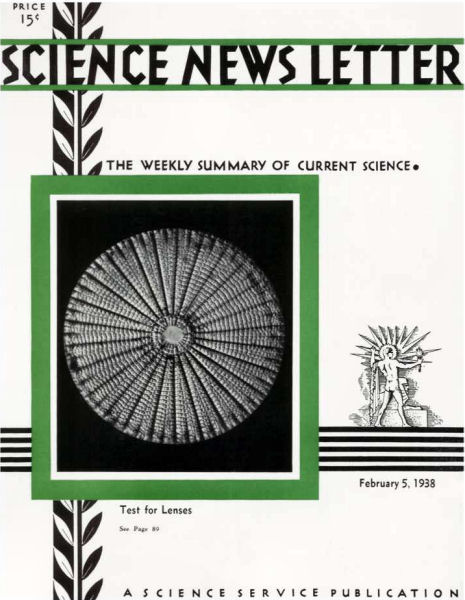From the February 5, 1938, issue

DIATOM SHELL MARKINGS TEST QUALITY OF LENSES
Diatoms, tiny one-celled water plants of a myriad forms, have long been standard test objects for microscopes. The exceedingly fine sculpturings and markings on their silica shells defy any but good lens combinations to bring them into sharp definition. On the cover of this week’s Science News Letter is the picture of one, a wheel-shaped form, taken with a new small-camera photomicrography set-up developed in the Kodak Research Laboratories.
NATURE CHANGED THE RULES 10 BILLION YEARS AGO
Nature changed the rules of the game of radioactivity 10 billion years ago, probably long before the Earth was formed. It was then that potassium, an element essential to life, began disintegrating radioactively, Dr. A.K. Brewer, chemist of the U.S. Department of Agriculture here, has determined.
Measuring the rate of breakdown of potassium into a kind of calcium, a component of limestone, then determining the time that this breakdown has been going on from the amount of this calcium now existing, Dr. Brewer finds that the process has been going on for about 10 billion years. In reaching this figure, he assumes that all of this special calcium, which has an atomic weight of 40 instead of 40.08 as does ordinary calcium, was derived from the breakdown of potassium, and that the breakdown rate has been uniform since it started. A similar time has elapsed since a variety of rubidium, a rare earth, started to break down into a kind of strontium, another rare earth.
Attempts to determine our planet’s age by studying the end products of radioactive breakdown, such as calcium derived from the decay of potassium, may be as futile as trying to find out how old a stove is by weighing the ashes. The method will show, Dr. Brewer believes, how long the disintegration has been going on or, more simply, how long the fire has been burning.
Dr. Brewer’s new studies in no way affect the ages determined for a number of rocks by radioactive methods. The amount of uranium, another radioactive element, in rocks is measured and then compared with the lead that it has added to the rock by uranium’s previous decay. The oldest rocks dated by this method are about 1.5 billion years old.
With Earth age estimated from a number of sources at not more than 2.5 billion years, some of the breakdown of potassium must have occurred before Earth was formed. Under present theories, the breakdown began on the sun, 7 or 8 billion years before that little star was torn apart to create the solar system.
How matter behaved under the old rules, in force until 10 billion or so years ago, before the formation of the solar system, Dr. Brewer will not state. His studies give no clue to older, now nonexistent states of matter.
Life, in the early days of our planet, hundreds of millions of years ago, may have been greatly affected by the radioactivity of potassium, says Dr. Brewer. Potassium is necessary to life, and if the minute fraction that is radioactive gets into a plant or animal, its radiations may damage the plant or animal and cause a sudden change of form, called a mutation.
Recently, by exposing fruit flies to X rays, similar to radium radiations, Dr. Calvin Bridges, California Institute of Technology geneticist, was able to produce freak flies in a very few generations. Millions of years ago, when radioactivity was stronger than at present, changes in life forms may have been greatly accelerated by radiations from this type of potassium.
Studies of the ages of rocks, using radioactive potassium as the clock, indicate to Dr. Brewer that their age cannot exceed 6 billion years and probably they are very much younger. Disintegration long ago of other elements, now completely broken down, may make this age entirely too large. More work on radioactivity, leading to a more exact, and probably smaller, value for rock age, is suggested by Dr. Brewer.
NEW FEATURES DISCOVERED ON FACE OF THE MOON
Revision of our maps of the moon may be necessary as a result of the discovery of a series of craters and walled plains near the edge of our satellite’s visible disk by H. Percy Wilkins, British astronomer.
Occupying 20 degrees of latitude on the southeast edge of the moon, this tangle of walled valleys, craters, and high peaks has escaped discovery for many years, chiefly because nobody looked there carefully enough until now. Commenting on Mr. Wilkins’ discovery, Dr. Walter Goodacre, acting director of the British Astronomical Society, recommended further observations of the moon’s edges, which may lead to additional discoveries.







